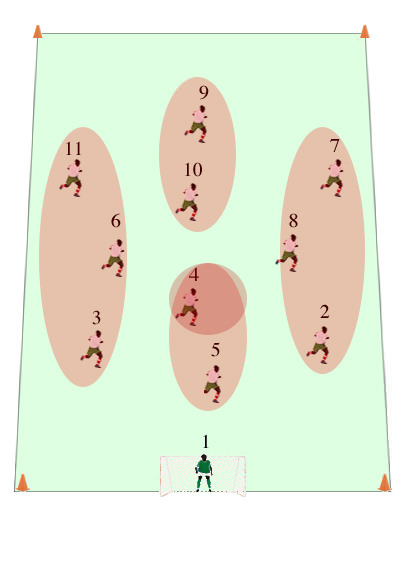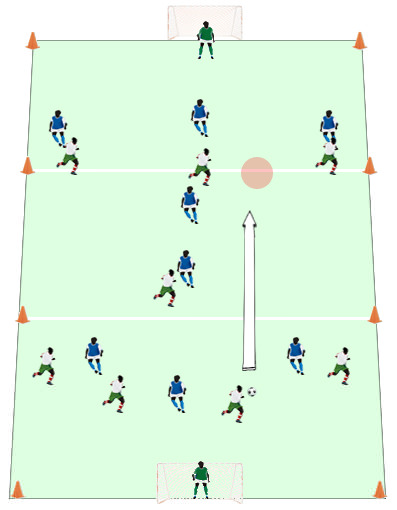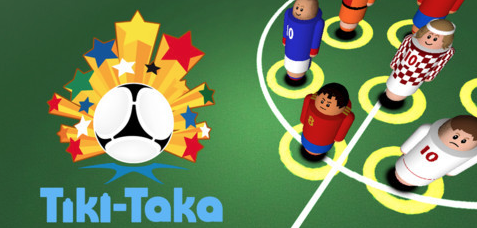Introduction: the foundations (part 2/5) – Positioning
This is a five-part series of articles that aims to introduce football coaches and fanatics to basic concepts in a systems football approach (such as tiki-taka). The systems approach to football is founded upon a system of complexity and unity
Please read both the Andre Villas-Boas approach and Brendan Rodgers philosophy articles to compliment what you may read here.
Read Part One Here: The Basics
———
Part two of this series briefly explores the complexities of positioning; I cannot stress enough that even with ten thousand words, it is not possible to cover every detail related to positional matters in a systems approach to football. Formations change dependant on many variables: possession, location, ownership of possession, pressing, covering etc. The following is instead, intended as an introduction to an understanding of a much bigger picture.
There are several overarching themes found in the array of approaches to systems football: the concept of spatial zones, player duties, practical space creation, positional relations and flexibility.
It is imperative that the system of formation that you set out to implement is explained well enough so that ideas can be transferred without any information lost. More important, however, is the level of flexibility that a coach can design for; the ability to slip between a back four and a back three dependant on the number of forwards the opponents play and the changeover in ownership of possession. Whether a centre back becomes a deep-lying midfielder or a full back becomes a wide midfielder is down to personal preference and team ability strengths.
When detailing formation to a team, players often make presumptions about what duties and roles he is expected to play. The same player can play as two very different players in two different positions – an almost unrecognisable change in playing style is not uncommon. While systems football does encourage player duties and roles, it is more important to consider your duties and roles dependant on the location of possession, rather than labelling yourself as a right-winger and being set in a mindset of consistently sprinting into space and beating your opponent only.
Below is the typical Ajax system under Louis Van Gaal in the 90’s (you could view this as anything from a 4-5-1 to a 3-4-3, 3-3-4, 4-3-3 etc by moving just two players [no. 4 and no. 10] into nearby positions):

The above diagram highlights that each position is not played in isolation when in possession; positional combinations carry a great weight of importance.
The circles in the diagram above are not suggestive that those players only have positional relationships with only those in the highlighted circle. The circles are merely to illustrate the ways in which basic level covering are related to one another.
Ruud Krol, Ajax left back in the 1970’s summarises this point perfectly:
“If I, as a left back (no. 3) , run 70 metres up the wing, it’s not good if I immediately have to run 70 metres back to my starting position. So if the left-midfield player (no. 6) takes my place, and the left-winger (no. 11) takes the midfield position, then it shortens the distances. If you run ten times seventy metres, thats a total of 1400 metres. If you change it so you must only run 1000 metres, you will be 400 metres fresher. That was the philosophy.” (Ruud Krol)
Therefore through player unity in perfect understanding Krol has worked to 71% of the usual.
The aim of this possession style of play is to increase the frequency at which your team has 3 V 2 situations – the extra man (triangles). To swing the ball from left to right and back again until a gap appears, a movement that aims to create a quality opportunity while in possession deep in the final third, in small and compact playing zones (re: el rondo in week one).
Therefore, beating a man in a confined space, overlapping and combination play are key areas for concentration. These areas of concentration are more relevant than repeatedly sprinting into space to receive the ball [note *combination play replaces this notion of individualistic attitude to receive the ball in space].
While 3 V 2 scenarios are encouraged during moments of keep ball, 1 V 1 scenarios are used effectively and sparingly to cause damage to the opponents defensive line. Usually the wingers in your team are capable of winning 1 V 1 scenarios, through pace or skill. Remember that in an action-reaction scenario, the player in control and making the action has the upper hand as the reactor has to react and therefore is always at a reaction-time deficit. Good defenders will attempt to gain control of the action-reaction scenario by forcing the forward into a position by offering space, this way the defender knows where the player with the ball is about to go and therefore the reaction time is cut significantly.
The same scenario is true of team movement through player combinations which can be explained and understood clearly through the following training session which encourages many of the concepts spoken about within these notes:
TRAINING SESSION 9 V 9
Objectives: high speed, fast ball, semi-rehearsed ball circulation; to improve the quality of the catalyst pass; to grasp the concept of differentiated zones; to create space where there is little; to rehearse off ball movement in expanding and concentrating space.
Organisation: three zones; play based on a positional system; in two-thirds it is two touch, in one-third it is one touch only.
This training method encapsulates many of the concepts involved in systems football, from those listed in the objectives to 1 V 1 in the final third and 3 V 2 elsewhere. Naturally space and tempo will be thought about in a more practical way than usual and pressing becoming clear when out of possession.
“Every player has to understand the whole geometry of the whole pitch” (Gerard van der Lem)
Diagram:

Commentary:
In the above scenario, the desired ‘found-space’ is in front of the right back. The right back is the third man, the intended player to be in possession when the centre back is on the ball. Think of the space in front of the right back, as the space teammates want to expand when the centre back is in possession. The ball is played forward into a tight space to draw away the opponents and then laid off into the desired space. Immediately after the ball finds the right back in this space, the appropriate players then compact the region to encourage keep ball in a more advanced position of the field. I call this the plug and drain method – one where the off ball movement is as important as the initial catalyst pass from the central defender.
Players will begin to understand the concept of creating space and then compacting it effectively. One moment the pitch is crowded and narrow, then next the space opens up for the right back and then in an instance the field is compact and possession is kept further up field.
The team in possession has this play rehearsed, they are two passes ahead of the opposition and therefore able to play the next four or five passes at great speeds with few touches.
This play is all about adjusting the lenses of off ball movement. It shouldn’t be as linear as to move into space to receive the ball selfishly. Selfless movement is as important.
Thinking about the space in front of the right back as an opening and clenching fist or as a living, breathing and beating heartbeat is key to this exercise.
————
Systems football is, among other things, a conceptual revolution based on the idea that the size of any football field is flexible and can be altered by the team playing on it. In possession, the formation should intend on creating space and therefore making the pitch as big as possible.
As players know the passing movement that is about to take place, player movement and formation changes take place to compact particular regions of the field: the 4-1-3 formation in the diagram above, very quickly becomes a 3-4-1 as players rotate accordingly.
Control is in the positional movement and relationships encouraged throughout the zonal concept of formation:
“the English don’t think until they have the ball at their feet…we don’t think about the first man. We think of the third man, the one who has to run. If I get the ball, the third man can run immediately because he knows I will pass to the second man, and he will give it to him. If I delay, the third man has to delay his run and the moment is over. It is that special moment, that special pass.” (Arnold Muhren)
KEY CONCEPTS TO CONSIDER
- Zonal attitudes and not positional attitude;
- shared player duties;
- thinking three/four passes ahead (third man movement) and catalyst passes;
- understanding (players and team) – the cogs;
- the covering;
- the movement;
- the zonal expectancies, positioning – with possession can be rehearsed to a certain extent;
- 3v2’s and 1v1’s;
- expanding and compacting space;
- formation with and without possession changes.
NOTE: sign up to www.thepathismadebywalking.com’s free newsletter to be the first to be the first to know when the Tiki-Taka Handbook is to be released: a coaching handbook accompanied with explanatory purpose designed training sessions (all versions: ebook etc) and 11 diagrammatic player handbooks (hard copy only).
Next Week (three): Defence
Week Four: Midfield
Week Five: Attack
———
Read Part One Here (Basics: Week One)

